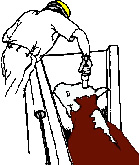Stunning
Stunning is the process of rendering animals immobile or unconscious, without killing the animal, prior to their being slaughtered for food. The practice of stunning has been adopted in many countries to reduce the pain and distress experienced by animals during slaughter. There are various methods of stunning, each suited to different types of animals and slaughterhouse facilities. The primary methods include mechanical, electrical, and gas stunning.
Methods of Stunning[edit | edit source]
Mechanical Stunning[edit | edit source]
Mechanical stunning involves the use of a captive bolt pistol or a firearm that delivers a blow to the animal's head, causing immediate unconsciousness. This method is commonly used in the slaughter of cattle, sheep, and some breeds of pigs. The effectiveness of mechanical stunning depends on the proper placement and calibration of the device.
Electrical Stunning[edit | edit source]
Electrical stunning passes a controlled electric current through the brain (head-only stunning) or the heart (head-to-body stunning) of the animal, causing temporary loss of consciousness. This method is widely used for pigs, sheep, and poultry. The parameters of the electric current, including voltage and duration, are critical to ensure the animal does not experience pain or distress.
Gas Stunning[edit | edit source]
Gas stunning involves exposing animals to gases or gas mixtures, such as carbon dioxide, that induce loss of consciousness. This method is primarily used for pigs and poultry. Gas stunning is considered to be less stressful for animals, especially when used in group stunning systems, as it avoids the need for individual handling and restraint.
Welfare Considerations[edit | edit source]
The welfare implications of stunning are a significant concern. Properly conducted stunning should render the animal insensible to pain until death ensues from the subsequent slaughter process. Inadequate stunning can lead to animals regaining consciousness before death, causing unnecessary suffering. Therefore, it is crucial that slaughterhouse personnel are adequately trained and that equipment is regularly maintained and calibrated.
Regulations and Standards[edit | edit source]
Many countries have established regulations and guidelines to ensure the humane treatment of animals at slaughter. These regulations often specify the acceptable methods of stunning, parameters for the application of those methods, and the qualifications required by personnel performing stunning. Compliance with these regulations is monitored by veterinary authorities or other regulatory bodies to ensure animal welfare standards are met.
Controversies and Ethical Considerations[edit | edit source]
The practice of stunning animals before slaughter has been a subject of ethical debate. While it is widely accepted as a means to reduce animal suffering, some critics argue that the very act of slaughtering animals for food is inhumane. Additionally, certain religious slaughter practices, such as those prescribed by Jewish and Islamic dietary laws, require animals to be fully conscious at the time of slaughter, which has led to exemptions from stunning requirements in some jurisdictions. These exemptions have sparked further debate regarding animal welfare and religious freedoms.
Conclusion[edit | edit source]
Stunning is a critical component of the modern slaughter process, aimed at minimizing the pain and distress experienced by animals. While the methods and effectiveness of stunning vary, the goal remains the same: to ensure that animals are rendered unconscious and insensible to pain before slaughter. Ongoing research and technological advancements continue to improve the efficacy and humaneness of stunning methods, reflecting society's growing concern for animal welfare.
| This article is a stub. You can help WikiMD by registering to expand it. |
Search WikiMD
Ad.Tired of being Overweight? Try W8MD's NYC physician weight loss.
Semaglutide (Ozempic / Wegovy and Tirzepatide (Mounjaro / Zepbound) available. Call 718 946 5500.
Advertise on WikiMD
|
WikiMD's Wellness Encyclopedia |
| Let Food Be Thy Medicine Medicine Thy Food - Hippocrates |
Translate this page: - East Asian
中文,
日本,
한국어,
South Asian
हिन्दी,
தமிழ்,
తెలుగు,
Urdu,
ಕನ್ನಡ,
Southeast Asian
Indonesian,
Vietnamese,
Thai,
မြန်မာဘာသာ,
বাংলা
European
español,
Deutsch,
français,
Greek,
português do Brasil,
polski,
română,
русский,
Nederlands,
norsk,
svenska,
suomi,
Italian
Middle Eastern & African
عربى,
Turkish,
Persian,
Hebrew,
Afrikaans,
isiZulu,
Kiswahili,
Other
Bulgarian,
Hungarian,
Czech,
Swedish,
മലയാളം,
मराठी,
ਪੰਜਾਬੀ,
ગુજરાતી,
Portuguese,
Ukrainian
Medical Disclaimer: WikiMD is not a substitute for professional medical advice. The information on WikiMD is provided as an information resource only, may be incorrect, outdated or misleading, and is not to be used or relied on for any diagnostic or treatment purposes. Please consult your health care provider before making any healthcare decisions or for guidance about a specific medical condition. WikiMD expressly disclaims responsibility, and shall have no liability, for any damages, loss, injury, or liability whatsoever suffered as a result of your reliance on the information contained in this site. By visiting this site you agree to the foregoing terms and conditions, which may from time to time be changed or supplemented by WikiMD. If you do not agree to the foregoing terms and conditions, you should not enter or use this site. See full disclaimer.
Credits:Most images are courtesy of Wikimedia commons, and templates, categories Wikipedia, licensed under CC BY SA or similar.
Contributors: Prab R. Tumpati, MD






